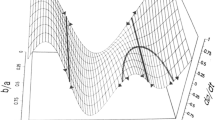Abstract
In this paper we set out a theoretical account of how we suppose commonsense reasoning about motion may develop. We identify some of the most primitive building blocks necessary to the construction of a psycho-logic of motion. Our analysis shows how such primitive elements could combine together to provide schemes of motion, recognisable in psychological accounts of infancy, which themselves generate both prototypes of and rules for motion used in commonsense reasoning. The theory takes as fundamental the basic (essentially Kantian) categories of commonsense reasoning: action, object, space, cause, time and movement. We also start with Piaget’s intuition that action and movement are primitive and fundamental to all development. A number of levels are suggested from the initial primitive schemes, emerging rules and prototypes, new prototypes from combinations, projection of prototypes onto other objects and elaboration. Examples are given of prototypes which are the link between the deep seated ways of thinking and commonsense reasoning.
Résumé
Cet article développe un cadre théorique permettant de rendre compte du développement des conceptions „naturelles” du mouvement. Les premiers éléments nécessaires á l’appréhension du mouvement sont identifiés. L’analyse montre que la combinaison de ces éléments primitifs peuvent se combiner et aboutir à des schèmes de mouvement chez l’enfant; ces schèmes générent des prototypes de mouvement et des règles que l’on retrouve dans le raisonnement du sens commun. La théorie s’appuie sur les catégories du sens commun, essentiellement kantiennes (action, objet, espace, cause, temps et déplacement) et sur l’intuition piagétienne selon laquelle l’action et le déplacement sont à la base du développement. Un certain nombre de niveaux sont envisagés, partant des schèmes primitifs, à partir desquels émergent des règles et des prototypes qui à leur tour permettront l’émergence d’autres objects. Des exemples de prototypes sont donnés qui permettent de faire le lien entre les formes de pensée les plus précoces et le raisonnement du sens commun.
Similar content being viewed by others
References
Andersson, B. (1986). The experiential gestalt of causation: a common core to pupils’ preconceptions in science.European Journal of Science Education, 8, 2, 155–171.
Bliss, J., Ogborn, J., & Whitelock, D. (1989). Secondary school pupils’ commonsense theorie of motion.International Journal of Science Education, 11, 3, 261-272.
Bliss, J., & Ogborn, J. (1991). A commonsense theory of motion: issues of theory and methodology examined through a pilot study. In P. Black & A. Lucas (Eds.),Childrens’ informal ideas about science (pp. 158–172). London: Croom Helm, Routledge.
Bower, T. G. R. (1967). The development of object permanence: some studies of existence constancy.Perception and Psychophysics, 2, 74–6.
Champagne, A. B., Kopfer, L. E., & Anderson, J. H. (1980). Factors influencing the learning of classical mechanics.American Journal of Physics, 48, 1074–1079.
diSessa, A. (1989). Knowledge in Pieces. In G. Forman & P. B. Pufall (Eds.),Constructivism in the Computer Age (pp. 49–70). Hillsdale, New Jersey: Lawrence Erlbaum Associates.
Flavell, J. (1963).The developmental psychology of Jean Piaget. Princeton. New Jersey: D. Van Nostrand Co. Inc.
Guidoni, P., Arca, M., & Mazzoli, P. (1983). Structures of understanding at the roots of science education, Part I: Experience, language and knowledge.European Journal of Science Education, 5, 367–375.
Guidoni, P., Arca, M., & Mazzoli, P. (1984). Structures of understanding at the roots of science education, Part II: Meanings for formalisation.European Journal of Science Education, 6, 311–319.
Guidoni, P. (1985). On Natural Thinking.European Journal of Science Education, 7, 133–140.
Hayes, P. (1979). The naîve physics manifesto. In D. Mitchie (Ed.),Expert Systems in the Microelectronic Age (pp. 242–270). Edinburgh: Edinburgh University Press.
Leslie, A. M. (1988). The necessity of illusion: perception and thought in infancy. In L. Weiskrantz (Ed.),Thought without Language (pp. 185–210). Oxford: Oxford University Press.
Lakoff, G., & Johnson, M. (1980).Metaphors we live by. Chicago: University of Chicago Press.
McDermott, L. (1984).Critical review of research in the domain of mechanics, Recherche en Didactique de la Physique, les Actes du Premier Atelier international, La Londes les Maures 1983, (pp. 137–182). Paris: C. N. R. S.
McCloskey, M., Caramazza, A., & Green, B. (1980). Curvilinear motion in the absence of external forces: Naîve beliefs about the motion of objects.Science, 210, 1139–1141.
McCloskey, M. (1983). Naîve Theories of Motion. In D. Gentner & A. L. Stevens (Eds.),Mental Models (pp. 299–324). Hillsdale, New Jersey: Lawrence Erlbaum Associates.
Ogborn, J. (1985). Understanding student’s understandings: an example from dynamics.European Journal of Science Education, 7, 141–162.
Piaget, J. (1937).La Construction du Réel chez l’enfant. Neuchâtel: Delachaux & Niestlé.
Viennot, L. (1979). Spontaneous resoning in elementary dynamics.European Journal of Science Education, 1, 205–221.
Viennot, L. (1985). Analysing students’ reasoning in science: A pragmatic view of theoretical problems.European Journal of Science Education, 7, 151–162.
Whitelock, D. (1990).Commonsense understandings of causes of motion, unpublished PhD thesis, Institute of Education, University of London.
Wiser, M., & Carey, S. (1983). When Heat and Temperature Were One. In D. Gentner & A. L. Stevens (Eds.),Mental Models (pp. 267–298). Hillsdale, New Jersey: Lawrence Erlbaum Associates.
Author information
Authors and Affiliations
Rights and permissions
About this article
Cite this article
Ogborn, J., Bliss, J. A psycho-logic of motion. Eur J Psychol Educ 5, 379–390 (1990). https://doi.org/10.1007/BF03173128
Received:
Issue Date:
DOI: https://doi.org/10.1007/BF03173128




